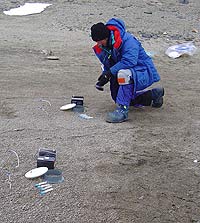
Position: Research Scientist
Education: PhD
Employer: Federal Government of Canada – Agriculture & Agri-Food Canada
What do you like most about your work?
What I like most about my work is the variety – no two days are the same. During the field season, I can often be found outside at the Experimental Farm in Ottawa, or travelling to other parts of the world, including New Zealand, Denmark, Vietnam, Sri Lanka, the UK, and the US. I’ve even had the chance to work in the Arctic and the Antarctic Dry Valleys, where people might be surprised to know that soils even exist! I have a laboratory where my research team made up of technicians, post-doctoral fellows and graduate students conduct experiments on soil, compost, plants and organic materials. It is one of the great pleasures of my job to be able to mentor young scientists and to benefit from all the new ideas they bring to my work.
A large part of my work consists of reading scientific papers that describe the research of others, designing new experiments of my own, and then writing up the results for publication in peer-reviewed journals and presentation at meetings and conferences. Keeping up on reading the scientific literature is what informs me about new developments in soil science and gives me new ideas. It also connects me to other scientists, and has led to wonderful working relationships and friendships with other scientists.
Why do you think it is important to study soil?
I like to think of soil as the living “skin” that enfolds the Earth. Without it, life on Earth could not exist. Everyone knows that soil is important for growing food and fibre for human use. As world population continues to grow exponentially, this role is becoming increasingly critical. However, most of the land in the world that is suitable for agriculture is already being used for that purpose. It may be possible to expand agricultural land a little, but that would come at the cost of losing other important land, like rainforests. This means that we will have to manage the soil we have wisely and efficiently, protecting this valuable resource and learning new ways to use it sustainably so that we can continue to feed people even as our numbers grow.
Why are soils like puzzles?
Soils are like puzzles because they present a large and complex picture composed of many parts. When you are putting a picture puzzle together, you often start by sorting the pieces first, maybe putting all the edge pieces into one pile or all the blue pieces together. In order to put the soil puzzle together and understand how soils function, you need to have at least five “piles”: 1) the climate they are found in (mean annual temperature and rainfall), 2) their location in the landscape (e.g., at the top or bottom of a hill), 3) the original material they came from (called parent material), 4) the vegetation growing on them, and 5) what humans use them for or how humans treat them. No single scientist has all the puzzle pieces. With so many different types of soil in the world, the puzzle is HUGE, but over time we are filling out the picture and getting a better understanding of how soil works and how incredibly important soil is to human survival. Working on a puzzle can be frustrating when many puzzle pieces are missing, but it is also really exciting when a new piece can be fit into puzzle and the whole picture starts to get clearer.